Introduction to IoT Development
The Internet of Things (IoT) is revolutionizing how we interact with the world around us. From smart homes to industrial automation, IoT development is at the heart of this transformation. This guide will walk you through the basics of getting started with IoT development, ensuring you have the knowledge to begin your journey in this exciting field.
Understanding IoT
IoT refers to the network of physical devices connected to the internet, collecting and sharing data. These devices range from simple household items like thermostats to complex industrial tools. The key to IoT is the seamless integration of hardware and software to create smart, responsive systems.
Essential Tools for IoT Development
To start with IoT development, you'll need a few essential tools:
- Development Boards: Platforms like Arduino and Raspberry Pi are perfect for beginners.
- Sensors and Actuators: These components allow your devices to interact with the physical world.
- Programming Languages: Knowledge of languages such as Python, C++, and JavaScript is beneficial.
- IoT Platforms: Services like AWS IoT and Google Cloud IoT provide the infrastructure to connect and manage your devices.
First Steps in IoT Development
Starting your first IoT project can be daunting, but breaking it down into manageable steps can help:
- Define Your Project: Start with a simple project, like a temperature monitoring system.
- Gather Your Components: Based on your project, select the appropriate hardware and software.
- Develop Your Device: Assemble your hardware and write the necessary code to make it function.
- Connect to the Internet: Use an IoT platform to connect your device to the internet and enable data sharing.
- Test and Iterate: Continuously test your device and make improvements based on feedback.
Challenges in IoT Development
While IoT development offers endless possibilities, it also comes with its set of challenges:
- Security: Ensuring your devices are secure from hackers is paramount.
- Scalability: Designing systems that can grow with your needs is essential.
- Interoperability: Making sure your devices can communicate with other systems and devices.
Future of IoT Development
The future of IoT is bright, with advancements in AI and machine learning paving the way for even smarter devices. As the technology evolves, so too will the opportunities for developers to innovate and create solutions that make our lives easier and more connected.
For those interested in diving deeper into IoT development, exploring our resources page can provide additional tools and tutorials to enhance your skills.
Conclusion
IoT development is an exciting field with the potential to transform our world. By starting with simple projects and gradually tackling more complex challenges, you can build a solid foundation in IoT development. Remember, the key to success is continuous learning and experimentation.
